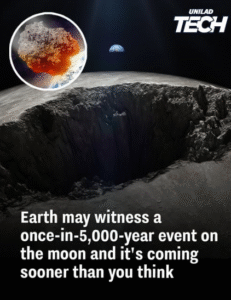Scientists are closely monitoring a rare cosmic event that could take place as soon as December 22, 2032—an asteroid impact on the Moon, believed to be a once-in-5,000-year occurrence. The asteroid, named 2024 YR4, was discovered in late December 2024 and initially sparked concerns due to its potential to collide with Earth. While further observations drastically lowered that risk, the possibility that it could strike the Moon remains real and scientifically significant.
2024 YR4 is estimated to be about 60 meters (approximately 197 feet) in diameter, a size large enough to cause a visible impact if it were to crash into the Moon’s surface. Early models gave it a small chance of impacting Earth, but improved data—especially from the James Webb Space Telescope—has shifted attention to a higher probability of a lunar strike. Current estimates suggest there’s around a 4.3% chance of the asteroid hitting the Moon during its 2032 close approach.
If the impact occurs, it could be the largest observed lunar collision in recorded history, with scientists suggesting that a similar event hasn’t taken place for at least 5,000 years. The potential collision is expected to release energy equivalent to approximately 6.5 megatons of TNT. The resulting crater on the Moon could be about one kilometer in diameter, and such a massive impact might even be visible from Earth with the naked eye under the right conditions.
Observers on Earth may witness a bright flash of light at the moment of impact, especially if it occurs on the Moon’s near side. The flash could be followed by a plume of dust rising from the Moon’s surface, visible through telescopes or possibly even unaided eyes. In the days following the strike, space agencies anticipate that lunar debris could disperse and possibly generate small meteor showers as fragments enter Earth’s atmosphere and burn up.
However, the potential effects aren’t limited to stunning visuals. Space scientists warn that ejecta from the impact—rocks and dust flung into space—could pose a threat to satellites and spacecraft operating between the Earth and the Moon. These fragments could persist in lunar orbit or Earth-Moon space for years, increasing the risk of micrometeoroid damage to critical space infrastructure. Agencies like NASA and the European Space Agency are preparing monitoring protocols to track any such debris should the impact occur.
Despite the relatively low probability, the scientific community is highly engaged. A lunar strike of this magnitude would offer an unprecedented opportunity to study real-time cratering processes, surface dynamics, and the effects of impacts in low-gravity environments. It would also help refine impact prediction models and improve future asteroid risk assessment.
This rare event has ignited public curiosity and interest in astronomy. Scientists are already planning coordinated global observations using ground-based telescopes, space-based instruments, and amateur astronomer networks. The Moon’s visibility to the public makes this event unique compared to other celestial phenomena, which often require specialized equipment or occur in inaccessible parts of the sky.
Moreover, the timing of the asteroid’s closest approach allows for continued monitoring and refined projections. Although the asteroid is too faint for detailed observation now, it is expected to become visible again in 2028. From then on, astronomers will gather more precise data to determine the asteroid’s trajectory and likelihood of lunar impact. Any updates on its orbit will influence global preparedness plans and observation strategies.
In the broader context, this potential lunar collision underscores the importance of near-Earth object tracking and planetary defense. While Earth remains safe in this scenario, the Moon’s vulnerability highlights the ongoing need to study cosmic threats. The event, if it occurs, would be a vivid reminder of our place in a dynamic solar system where celestial objects frequently interact in dramatic ways.
As scientists prepare to watch the skies, the general public is encouraged to stay tuned for updates. Whether or not the impact happens, the lead-up to December 2032 will serve as a global educational moment about asteroids, the Moon, and our shared cosmic environment.
In summary, the possibility of asteroid 2024 YR4 colliding with the Moon presents an extraordinary astronomical event. It is rare, potentially historic, and filled with scientific value. The world may be on the verge of witnessing a spectacle not seen in thousands of years—one that could reshape our understanding of lunar science and deepen humanity’s appreciation for the ever-changing skies above.


